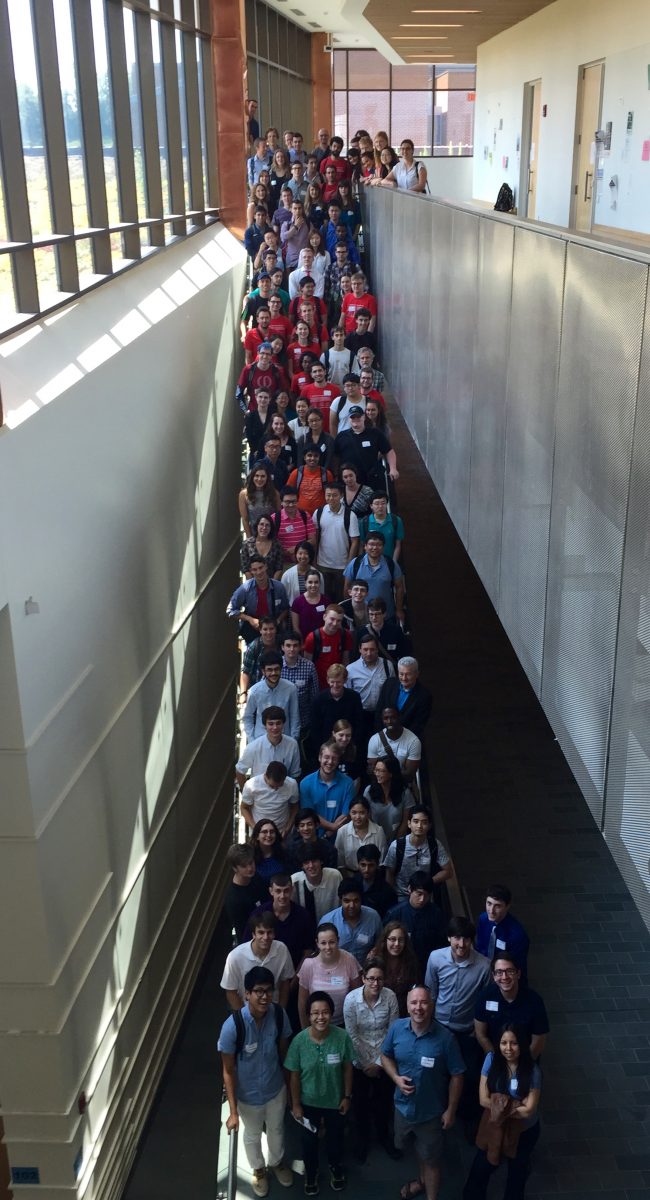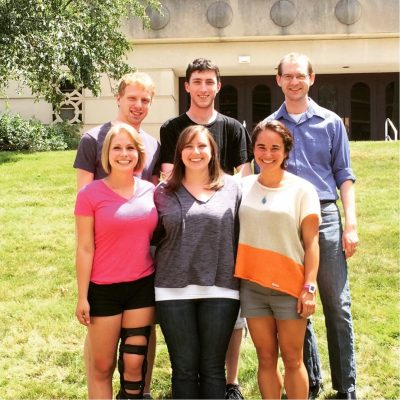
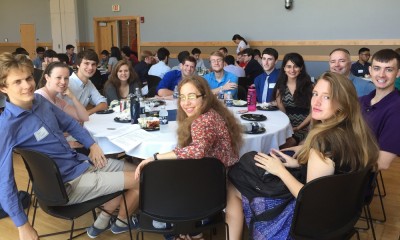
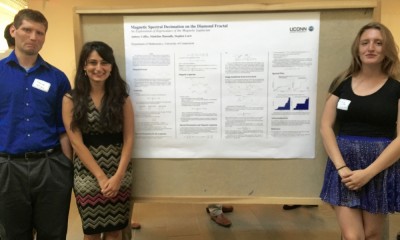
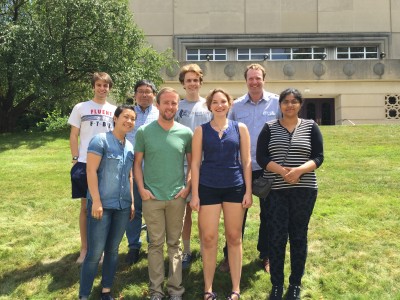
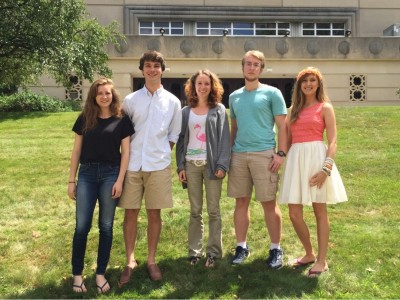
Major Activities:
The main activity for the REU participants was their research projects. In summer 2015 there were
seven projects, three in analysis on fractals, two in mathematics education, one in representation theory and one in stochastics.
Project 1: Power dissipation in fractal AC circuits.
Students learned about Feynman’s example of an infinite ladder circuit consisting of non-dissipative elements that has the property that the circuit is dissipative. They then constructed fractal examples that generalize this property and identified equilibrium distributions (harmonic functions) of these networks. The results are written up a paper that is available on the arXiv and has been submitted for publication. They were also presented in talks at the 3rd Northeast Mathematics Undergraduate Research Mini-Symposium, UConn CT, July 2015 and an American Mathematical Society meeting at Stony Brook University, NY, March 2016.
Project 2: Wave propagation in a fractal medium.
Spectral decimation methods allow the computation of exact values of Laplacian eigenfunctions on vertices of certain approximations of fractal sets. In this project students studied an interval with a fractal measure and associated Laplacian. Using computer code for spectral decimation written by an earlier REU group they undertook an extensive analysis of a certain notion of the rate of wave propagation, specifically the propagation properties of a wavefront of fixed height. They also studied the dependence of propagation properties on a parameter that determined the structure of the fractal measure. The structure was quite complicated and is not yet completely understood, however the students obtained some significant partial results. Results were presented in a poster at the 3rd Northeast Mathematics Undergraduate Research Mini-Symposium, UConn CT, July 2015 and are being written up for publication.
Project 3: Uniform magnetic field on the Diamond Lattice Fractal.
Building on research performed by the 2013 REU students, as well as classical mathematical physics results of Belissard et al and graph spectrum techniques of Malozemov-Teplyaev, the students investigated the spectral properties of magnetic operators on the Diamond Lattice fractal. They were able to show that a generalization of the results of Malozemov-Teplyaev are applicable to a class of uniform magnetic operators on this fractal and thereby compute the spectra of these operators. The results were presented in a talk and a poster at the 3rd Northeast Mathematics Undergraduate Research Mini-Symposium, UConn CT, July 2015, a talk at an American Mathematical Society meeting at Stony Brook University, NY, March 2016, and at the 2015 MathFest, Washington DC, August 2015, where the talk won a Pi Mu Epsilon award. A paper is in preparation.
Project 4: Mathematics and intercultural competence (ICC) in the middle school.
Students reviewed literature on ICC, in particular Michael Bryam’s model, and its application in mathematics classes, and used this foundation to create two assessment tools for tracking the development of ICC during the school year. The tools are a survey which assesses attitudes towards and knowledge of cultures and learning across content areas, and a rubric to assess interactions and reflections. They also created lesson plans for incorporating ICC and Common Core standards in 3rd, 6th,and 9th grade classes. The assessment tools are being used in an ongoing collaboration between UConn researchers and the Farmington school district this academic year. Results have been presented in talks at the 3rd Northeast Mathematics Undergraduate Research Mini-Symposium, UConn CT, July 2015, the AMS-MAA joint meeting in Seattle, 2016, the Sacred Heart Academic Festival, Fairfield CT, April 2016.
Project 5: Investigating the interplay of argumentation and mathematics in classroom tasks.
There is a strong emphasis on argumentation in the new Common Core State Standards of Mathematics: the third Standard for Mathematical Practice highlights argumentation as an expertise all students should develop. In this project the REU students analyzed a collection of tasks designed by elementary and high-school teachers to teach argumentation in mathematics. They assessed how argumentation affected the cognitive demand levels of the tasks, as well as how argumentation detracts from or contributes to the mathematical content in the tasks. They showed a change in cognitive demand levels when tasks were analyzed with and without the argumentation component, and described 5 themes that emerged from the interplay of argumentation and mathematical concepts, some of which were common to both elementary and high school tasks. A talk on this work was presented at the 3rd Northeast Mathematics Undergraduate Research Mini-Symposium, UConn CT, July 2015.
Project 6: Minimal Length Maximal Green Sequences and Triangulations of Polygons.
Students used combinatorial properties of quivers and the corresponding surfaces to study maximal green sequences of minimal length for quivers of type A. They proved that such sequences have length n+t, where n is the number of vertices and t is the number of 3-cycles in the quiver, and developed a procedure that yields these minimal length maximal green sequences. Their paper is available on the arXiv and has been submitted for publication. Talks based on this work have been presented at the 3rd Northeast Mathematics Undergraduate Research Mini-Symposium, UConn, 2015, the Council on Undergraduate Research REU Symposium in Arlington, VA, October 2015, the UC Berkeley Combinatorics Seminar, September 2015, the AMS-MAA joint meeting in Seattle, January 2016, the Hudson River Undergraduate Math conference, Colchester VT, April 2016.
Project 7: Stabilization by noise of a C^2-valued coupled system.
Recently, Herzog and Mattingly gave an example of a C-valued polynomial ODE with finite-time blow-up solutions that may be stabilized by adding Brownian noise. In this project the students used numerical and analytic techniques to study a version of Herzog and Mattingly’s result on C^2, examining a system of coupled ODEs with finite blow-up. They were able to show that the system could be stabilized by adding a suitable Brownian noise, and that the resulting system of SDEs is ergodic. Their paper is available on the arXiv and has been submitted for publication. Talks based on this work were presented at the 3rd Northeast Mathematics Undergraduate Research Mini-Symposium, UConn, CT, July 2015, the 14th NorthEast Probability Seminar at Columbia University, NY, November 2015, the AMS-MAA Joint Meeting in Seattle, 2016, and the Rutgers Probability seminar, April 2016.
